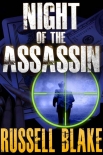Night of the Assassin: Assassin Series Prequel Russell Blake (red novels txt) 📖

- Author: Russell Blake
Book online «Night of the Assassin: Assassin Series Prequel Russell Blake (red novels txt) 📖». Author Russell Blake
Particularly tonight, when La Familia, a rival splinter faction of the Gulf cartel, had decided to use the Mexican marines as a vehicle to cause their competitors grief, by tipping law enforcement off to the shipment. It was not unusual for the cartels to exchange information with the military or the police to create problems for their enemies – most of the drug seizures that took place did so because of the constant infighting and jockeying for advantage that was a routine aspect of the trade. It was far more ergonomic to use the military’s muscle instead of your own, and if the rivals got into a firefight in the process, so much the better.
The marines had long been considered the only incorruptible branch of the military. The army was notoriously riddled with rot but the marines, for whatever reason, couldn’t be bought off, and so were the most feared of the law enforcement branches. In Mexico, the army and navy worked alongside the police and Federales for internal security, which included battling the drug cartels, especially since the recent reorganization into more specialized groups. It hadn’t been broadly publicized, but since 2000, when Vincente Fox became president of Mexico, the country had been embroiled in a de facto civil war, with the cartels having far greater resources than the army and navy. The total budget for the army was less than a percent of GDP, which put it at considerably under a billion dollars. Contrast that to the over fifty billion dollars per year in wholesale value of cocaine that moved through the cartels. At an eighty to ninety percent margin, that left the narcotraficantes with vastly greater resources than the army.
Since the Mexicans had taken over cocaine trafficking for the Colombians, and begun manufacturing methamphetamines in earnest, the money had gotten crazy. Mexico found itself in much the same situation Colombia had faced in the 1980s and 1990s, when it was routine for judges, police chiefs and army generals to be executed en masse by the Colombian cartels, or rather their armed enforcers; the myriad purportedly revolutionary groups that controlled half the country and increasingly acted as armies for the cartels.
The lion’s share of the profits had shifted from Colombia to Mexico as Colombia contented itself with the far lower-risk and less violent business of production, leaving the transport and distribution to their better-positioned Mexican associates. The profits in Colombia were still significant, with one to two hundred percent markup to the Mexicans, but the margin in trafficking was five to tenfold. A kilo of cocaine that cost the Mexicans twenty-five hundred to three-thousand dollars in Colombia would fetch twenty-five thousand a kilo wholesale across the U.S. border, and that was usually significantly cut with buffering agents in order to dilute the nearly pure cocaine, thereby increasing the apparent quantity once repackaged for the States; so in actuality it was more like an effective thirty to thirty-five thousand sale price for that original kilo by the end of the day.
The incredible margins were a direct function of the illegality of the substances in the target market – the United States. As with alcohol margins during the ill-fated experiment of Prohibition in the 1930s, criminalization of drugs turned what would have been a five percent profit business into a thousand or more percent trade, which created windfall profits for everyone in the supply chain and also created a situation where every aspect was worth killing for. There were no open gun battles over cigarette profits or alcohol profits because once a substance was legal, the efficiencies of the distribution chains kicked in and it became a boring commercial enterprise. But keeping the substances illegal, especially since they were in huge demand, caused profits to go through the roof.
And so it was that a group of provincial, unsophisticated Mexican farmers became the most powerful narcotics trafficking empires in the world, commanding the sorts of budgets that medium-sized countries had. Mexico bore the brunt of the violence that ensued from the power struggles, principally because it was the geographic gateway to the largest market for drugs in the world – the United States.
The harbor was quiet at three a.m., and the wharf area where Caruso was tethered was deserted, save for two men smoking cigarettes on the concrete pier, and a disinterested security guard at the massive dock’s entry point, where it connected to land. The marines had taken position in the surrounding buildings, having been told that there was a complement of at least a dozen heavily-armed men on board, guarding against any incursions to steal their precious cargo.
The leader of the commando team made a series of hand signals, and the men fanned out, while Raul set up his rifle tripod and adjusted his scope. Range was six hundred meters at the closest point, which would be a cakewalk for him were it not for the twenty knot gusting breeze he’d need to factor in. This was his first active operation since graduating from the special forces course so he felt a tingle of anticipation before finally testing his skills in a real-world environment. Shooting at paper targets or silhouettes on a range was one thing, but being in the thick of it with enemies who were shooting back was quite another.
This operation would be a tricky one, in that the commander didn’t want to get into a gun battle if he didn’t have to. His first plan was to use subterfuge and approach the ship with several plain-clothed men under his command, subdue the two lookouts with stun guns, and then move the bulk of the commandos swiftly down the dock to the gangplank, boarding the old scow





Comments (0)